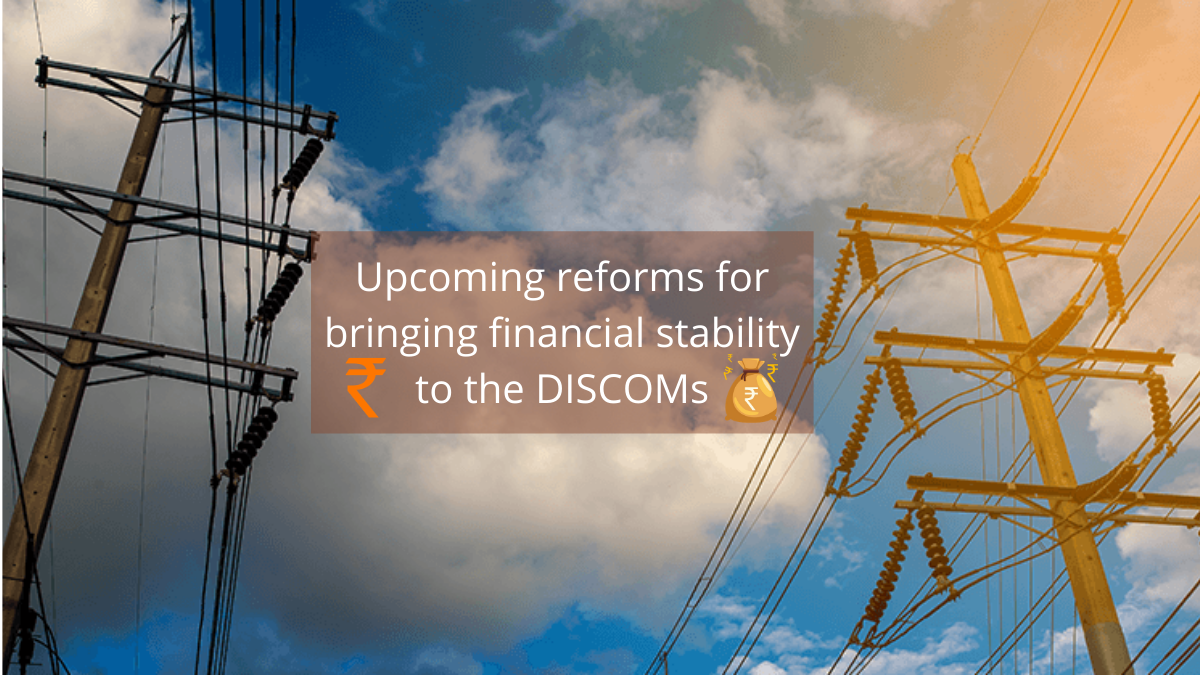In a previous blog detailing our views on the impact of the Union Budget on the power sector, we referred to the proposed revamped, reforms-linked scheme providing assistance to DISCOMs. At the time, details on the scheme were forthcoming. Recently, the Central Government circulated the draft guidelines on the new scheme and invited comments from State Governments and State DISCOMs. These guidelines reveal the architecture of the proposed scheme – an ambitious initiative to address the financial viability of DISCOMs.
Background
Ensuring financial viability of DISCOMs has long been a policy focus for policy makers and successive governments. The Ujwal DISCOM Assurance Yojana (UDAY) launched in 2015, was the latest initiative envisaging financial turnaround of DISCOMs along with operational improvement. While the scheme has had an impact in improving operational efficiencies and increased capital investment, all India AT&C loss is 24.31% and ACS-ARR gap (gap between average cost of supply and average realizable revenue) is Rs. 0.56/Unit. These headline numbers reveal the need for a scheme to further the gains made from UDAY. Furthermore, steps have been taken towards automation and IT in the distribution sector on account of schemes like IPDS and R-APDRP.

Objective of the Scheme
The proposed scheme seeks to:
- Improve the quality, reliability and affordability of power supply through financially sustainable and operationally efficient distribution sector
- Reduce AT&C losses to 12%-15% pan India by FY 2024-25
- Reduce ACS-ARR gap to zero by FY 2024-25.
Ongoing schemes such as IPDS, DDUGJY will be subsumed under this scheme.
About the Scheme
The scheme has the following components:
- Part -A: This part consists of metering, distribution infrastructure works and project management
- Metering: End-to-end Advanced Metering Infrastructure (AMI) solution, 100% consumer metering through prepaid or smart prepaid mode, 100% communicable DT & feeder metering with AMI and existing feeder online monitoring system will be integrated within AMI system
- Works related to loss reduction: substation augmentation, Aerial Bunched Conductors (ABC) in high loss areas, segregation of feeders, replacement of conductors, SCADA in all urban areas, DMS in 100 urban centers, HVDS systems and distribution works for system strengthening
- Furthermore, Project Management Agency will be appointed by DISCOMs
- Part – B: Training, capacity building and other enabling activities
Funding Pattern of this scheme is given below:
| Sr.no | Item | Quantity (nos) | Outlay (Rs.Cr) | Grant from central government (Rs. Cr) |
| 1 | Prepaid smart metering at consumer, DT and feeder level | 25 Crores | 1,50,000 | 22,500 |
| 2 | Other costs | Lumpsum | 800 | 800 |
| 3 | Part -A funding for smart metering | 1,50,800 | 23,300 | |
| 4 | Distribution infrastructure: SCADA, DMS, AB cables, feeder segregation, etc. | 1,51,528 | 73,301 | |
| 5 | Training, capacity building, etc. | 1,430 | 1,030 | |
| 6 | TOTAL | 3,03,758 | 97,631 |
Eligible Entities
State owned DISCOMs and State Power Departments. Private utilities are excluded
Action Plan
A major facet of this scheme is the fact that financial assistance is linked to reform and a results-based framework. With this in mind, participating DISCOMs are to prepare an action plan specifically stating reform measures which would improve operational efficiency and financial viability. The action plan has to detail the following:
- Infrastructure works that are required for AT&C loss reduction and, improving power quality and reliability of power supply.
- Analysis of reasons for losses and measures that will be taken up to reduce AT&C losses and reduce ACS-ARR gap. Roadmap for bringing down AT&C losses and reducing ACS-ARR gap to zero by FY 2024-25 should also be included
- Based on the action plan, outcome and output parameters will be identified and spelt out in the form of a Results Evaluation Matrix.
- In case the DISCOM is found ineligible according to the Results Evaluation Matrix, gap in funding will be provided by the State Government
Project Implementation
Rural Electricity Corporation and Power Finance Corporation have been proposed as the Nodal Agencies for this scheme. A tripartite agreement would be signed among the State Government, DISCOM and Central Government. Tripartite agreement would include the following clauses:
- Parties would adhere to the roles and responsibilities under the agreement
- Performance of the DISCOM under this scheme would be a pre-qualifying criterion for any counterpart financing under this scheme as well as beyond this scheme by PFC, REC, Banks/FIs, etc
While implementing this scheme, DISCOMs should adhere to Orders issued by the Ministry of Power towards Make in India initiative of the Government of India. The sunset date for this scheme is proposed to be 31.03.2026 beyond which no Central Government Funds will be released.
Results Evaluation Framework
Based on the action pan submitted by the participating DISCOMs, a Results Evaluation Framework would be formulated. Various pre-qualifying criteria pertaining to publishing of unaudited/audited accounts, non-creation of regulatory assets, 100% payment of subsidy by the State Government, timely issuance of Tariff Order, etc., have to be adhered to prior to evaluation. The matrix would be evaluated based on the following categories:
| Sr.no | Category | Weightage |
| 1 | Financial Stability | 60 |
| 2 | Outcome of infrastructure works | 20 |
| 3 | Infrastructure Works | 10 |
| 4 | Policy & structural reforms, capacity building and IT/OT enablement | 10 |
| Total | 100 |
For qualifying in the matrix, each participating DISCOM has to score minimum of 60 marks. Interestingly, adoption of PPP mode has been included among the parameters that would be evaluated in the section on structural reforms.
Performance Evaluation
This proposed scheme states that a third-party agency would carry out a mid-term evaluation on the basis of progress made in FY 2021-22 and FY 2022-23. Post completion evaluation would also be done.
Summary
This proposed scheme for the reform of the distribution sector builds on the gains made by schemes like IPDS, UDAY etc., and specifies a mechanism to ensure financial sustainability of DISCOMs. As the market leader in the electrical test and measurement, we at SCOPE are excited that the scheme specifically stipulates that the Make in India guidelines have to be followed by DISCOMs.
However, the scheme is not open to private utilities, thereby creating an uneven relationship among State owned and private DISCOMs. The scheme proposes an effective mechanism to address regulatory concerns such as timely payment of subsidy by State Governments, timely payment of dues, non-creation of regulatory assets and timely issuance of tariff orders. However, this mechanism is not open to privately owned DISCOMs.
The Central Government, State Government and State owned DISCOMs are set to discuss these guidelines, and subsequently, the scheme is set to be finalized and made operational by the Central Government. We at SCOPE hope for a speedy resolution of this process and congratulate the Central Government on this ambitious scheme.


Really Interesting area for furthering reforms in Indian Power sector
LikeLike
thank you sir.
LikeLike